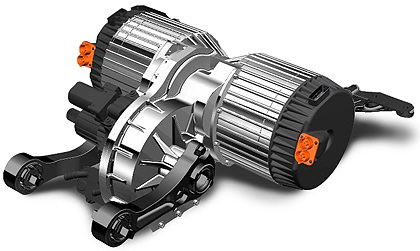UK-developed EV motors are ‘world’s most sustainable’

A British start-up motor developer has announced what it claims are the world’s most sustainable motors for electric vehicles (EVs). Advanced Electric Machines’ motors contain no rare-earth magnets or copper windings. It says they offer all of the performance and efficiency benefits and permanent magnet motors, without their environmental drawbacks.
AEM was founded in 2017 when it was spun out from Newcastle University’s electric motor research team, led by CEO James Widmer, and chief technology officer Andy Steven. It has already attracted more than £25m of investment to develop its technologies through a combination of government grants and equity investment. It is now looking for another £30m in the next few months to boost UK production, and aims to raise a further £220m within a year to fund further growth.
AEM, located in the North East of England, says that it has manufacturing facilities in place that can scale to produce 12,000 motors or more to meet near-term demand. It is hoping to raise its capacity to at least 100,000 motors per year. Work is also underway to roll out global expansion to meet longer-term demand. AEM has registered several international patents to protect various aspects of its technology.
The company is offering two families of the switched reluctance motors (SRMs):
• the HDSRM machines, aimed at commercial vehicle applications which need high levels of continuous performance and long service lives; and
• the SSRD motors, aimed at passenger vehicles and claimed to deliver 50% more power for 35% less weight than leading permanent magnet (PM) motors for passenger cars.
“Uniquely” for SRMs, the HDSRM motors operate with the standard power electronics used by most EV drivetrains. Patented technologies also ensure that, unlike previous SRMs, they operate quietly and with minimal torque ripple.
The HDSRM motors are said to match the performance of leading PM motors of the same size, while promising higher efficiency. They also offer robust construction, no risk of demagnetisation due to overheating, and the ability to freewheel without electromagnetic losses. These benefits can result in longer ranges and lower drivetrain costs than alternative technologies.
AEM is currently offering the HDSRM motors in three configurations, and is already delivering them to customers on three continents. The standard version, which weighs 75kg and is liquid-cooled, delivers up to 214kW and a peak torque of 380Nm. An second version increases the torque to 520Nm and the peak power to 166kW. There is also a smaller, air-cooled version that weighs 25kg and delivers a peak torque of 100Nm and a peak power of 50kW.
The modular motors can be scaled to higher power and torque levels. Alternatively, several HDSRM motors can be combined to deliver more flexible power and torque capabilities and a wider peak efficiency zone. The motors can also be paired with internal combustion engines to act both as traction motors and generators for hybrid vehicles. AEM has also developed a gearbox that can be driven by up to three HDSRM motors to achieve a peak torque output of 4,200Nm.
AEM says that the SSRD motors for passenger vehicles can deliver performance levels that already meet industry targets for 2035. They can achieve power densities of up to 29kW per litre – more than ten times higher than permanent magnet motors. They can deliver from 125kW as a single motor up to 600kW as a lightweight e-axle, and are said to be cost-effective to produce with lower materials costs than PM motors. AEM says they offer a potential 10% improvement in efficiency over today’s standard drive cycles, as well as 100% recyclability.

The HDSRM and SSRD motors avoid the need for rare-earth materials such as neodymium and dysprosium which have significant environmental impacts. Every tonne of rare-earth material mined produces up to 1.4 tonnes of radioactive waste, 200m3 of acid-containing sewage water, 60,000m3 waste gas containing hydrochloric acid and 27.6 tonnes of CO2. Based on a global car production of 97 million vehicles, AEM calculates that its technologies could prevent 133 million tonnes of CO2 emissions per year, as well as 300,000 tonnes of radioactive waste.
There is also concern over the long-term security of supply of rare-earth materials. China dominates the global supply of these materials. Between March 2020 and March 2021, the price of neodymium rose by more than 240%.
As well as rare-earths, conventional permanent magnet motors also need copper windings. At end of the motor’s life, the copper has to be removed from the motor before recycling – a difficult and costly process. AEM’s motors, which are formed from only steel and aluminium, can be recycled quickly, cost-effectively and completely.
AEM is also working in a collaborative project with Bentley Motors, Hypromag, Intelligent Lifecycle Solutions, Unipart, and the University of Birmingham, to recycle rare-earth magnets that have already been disposed of. The recycled materials will be used in smaller motors such as automotive ancillary drives and high-efficiency drones.






